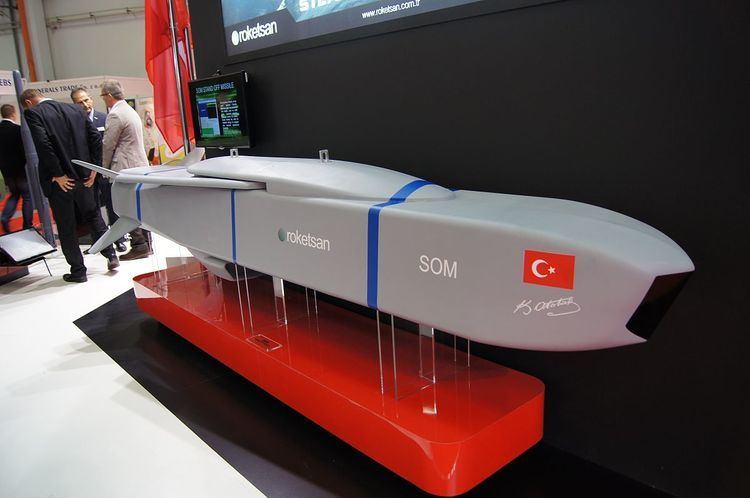In service Since 2012 | ||
 | ||
Type Cruise missileAnti-ship missile Manufacturer TÜBİTAK-SAGE and RoketsanSOM-J to be additionally produced by Lockheed Martin under licence from Roketsan Weight 600 kilograms (1,323 lb) Length 3,657 millimetres (12.0 ft) | ||
SOM Cruise Missile (Turkish: Satha Atılan Orta Menzilli Mühimmat) is a next-generation high precision cruise missile, which can be launched from land, sea and air platforms developed by TÜBİTAK SAGE, Defence Research and Development Institute of Turkey. It was first revealed during the 100th anniversary celebrations of the Turkish Air Force at the Çiğli Air Base in İzmir, on 4 June 2011. Developed since 2006, the SOM cruise missile is Turkey's first domestic solution for destroying both stationary and moving targets at a stand-off distance of over 180 kilometers. Although being developed by TÜBİTAK SAGE which still holds authority over the design of the missile, Roketsan has been given the role of producing and marketing the missile for export.
Contents
Description
The SOM stand-off cruise missile is a family of launch and leave precision strike weapons against both land or sea targets. It uses GPS as its primary mode of guidance complemented by an advanced Inertial Navigation System and a radar-based Terrain Referenced Navigation system, allowing the missile to skim the terrain during its flight in order to evade local defence systems. According to the developer, it features advanced geometry and aerodynamics over similar missile systems, as well as lightweight composite components that minimize the radar cross-section of the missile. A terminal stage infrared imager detects the individual target by matching its signature with a pre-loaded database of similar targets allowing for precision strike. It can also be used to provide image-based midcourse navigation by taking snapshots of waypoints and comparing them against predicted position to update the navigation system. By this way, if GPS capability is denied or degraded, the missile can follow its waypoints using infrared based terrain updates. The missile includes a two-way datalink that makes possible to change the task in flight.
Basic design of the missile incorporates dedicated fuselage that fits in the internal bays of the Joint Strike Fighter.
It is intended to achieve high accuracy in striking military targets like command and control facilities, SAM sites, parked aircraft and surface ships.
Tests
According to the TUBITAK-SAGE officials, the initial demonstration flights of the prototypes were completed successfully. The missile made its first guided flight on 9 August 2011 over the Black Sea. Covering more than 100 nautical miles using GPS/INS guidance, the missile successfully hit its target with high accuracy. It is planned to assess the design aspects of the missile by conducting about 30 test flights. The delivery of a first batch of missiles to the Turkish Air Force will take place by the end of 2011, following more complicated live firing tests planned for the rest of the year.
Range
While initially the range of the missile was announced to be 100 nmi, debates arose in local press around the missile's real range after Prime Minister Recep Tayyip Erdogan unexpectedly set objectives for the development of a missile with a range of 2,500 km (1,300 nmi) at the plenary session of the High Science and Technology Council on December 28, 2011. Shortly after, head of the Scientific and Technological Research Council of Turkey (TÜBİTAK) Yücel Altınbaşak informed that they set a task to develop the missile to 2,500 km (1,300 nmi) within 2 years. "The SOM missile is currently tested for 300 km (160 nmi) range and successfully achieved 10 m (33 ft) precision goal, demonstrating around 5 m (16 ft) accuracy in live fires. We are planning to start 500 km (270 nmi) range tests this year. Later the range will be extended to 1,500 km (810 nmi) and finally to 2,500 km (1,300 nmi) in 2014", he said.
Variants
TUBITAK-SAGE developed the missile in three variants with varying warheads and guidance/communication packages:
Partnership with Lockheed Martin [US]- Integration with Joint Strike Fighter (JSF)
On 24 October 2014 Roketsan of Turkey and Lockheed Martin entered into a teaming agreement whereby the parties would modify, produce and market jointly a new variant of the SOM missile dubbed SOM-J for use in the internal carriages of the F-35. Certification efforts are in progress to enable the SOM missile for integration with both Turkish Air Force F-35 Lightning II and NATO allied F-35. Lockheed Martin Missiles and Fire Control executive vice-president Rick Edwards has stated that the SOM missile developed by Roketsan is highly advanced and highly effective against command-and-control facilities, surface-to-air missile sites, parked aircraft and surface ships.
Due to its advanced design and performance the SOM cruise missile is one of two cruise missiles to be integrated with the F-35, the other being the Joint Strike Missile developed by Kongsberg Defence & Aerospace of Norway. On the 10th of May 2013, Lockheed Martin had officially announced at the F-35 Industry Recognition Event during the IDEF tradeshow that the SOM missile will be certified and deployed on the F-35.
The SOM Missile is the first non-U.S. made weapon to use the Universal Armaments Interface (UAI). Accordingly, the SOM missile can be integrated onto any platform which uses UAI.
